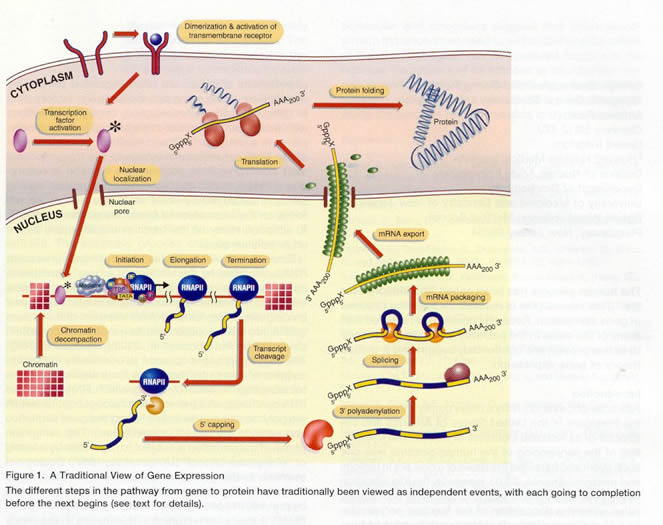
The cellular world:
Cells carry out a bewildering variety of functions in all living things, but twenty-eight different sub-functions have been simulated through bioengineering to reveal a significant amount of complexity that accounts for the life of animal, plant, bacterial, and fungal cells.
Ribosomes, composed of RNA and protein, are important organelles inside of cells. 
The bead like ribosomes are the site of protein synthesis. Thousands of them can be found in all cells, and they are found either free-floating in the cytoplasm or attached to the endoplasmic reticulum. When synthesizing, most ribosomes attach themselves to a messenger RNA (mRNA) which provides genetic information.
This genetic information is translated into amino acids, the building blocks of proteins. Since the ribosome itself is not specific to any one protein, all ribosomes can build thousands of different types of proteins.
Ribosomes can synthesize new membrane proteins for the endoplasmic reticulum, the nuclear membrane, the Golgi complex, lysosomes, and the plasma membrane, among other things such as digestive enzymes.
 Ribosomes work most with the endoplasmic reticulum. Basically, the ribosomes work on synthesizing proteins, and the endoplasmic reticulum carries the products to where they need to go. Ribosomes that produce proteins for use in the nucleus tend to be the free-floating ribosomes in the cytoplasm; their products float inward until they reach the nucleus. If the product of a ribosome attached to the endoplasmic reticulum needs to go elsewhere, the endoplasmic reticulum carries the product outward, where it forms a vesicle and travels to the Golgi complex. From there, it might be altered and then go on to the cell membrane or a lysosome, or be excreted out of the cell through exocytosis. Ribosomes also help synthesize new parts of the endoplasmic reticulum.
Ribosomes work most with the endoplasmic reticulum. Basically, the ribosomes work on synthesizing proteins, and the endoplasmic reticulum carries the products to where they need to go. Ribosomes that produce proteins for use in the nucleus tend to be the free-floating ribosomes in the cytoplasm; their products float inward until they reach the nucleus. If the product of a ribosome attached to the endoplasmic reticulum needs to go elsewhere, the endoplasmic reticulum carries the product outward, where it forms a vesicle and travels to the Golgi complex. From there, it might be altered and then go on to the cell membrane or a lysosome, or be excreted out of the cell through exocytosis. Ribosomes also help synthesize new parts of the endoplasmic reticulum.
Lewis Thomas' metaphor | life's scale | Richard Lewontin on variability
Marcus W. Covert. "Simulating a Living Cell", Scientific American, Vol. 310:#1, January 2014, pp. 44-51.